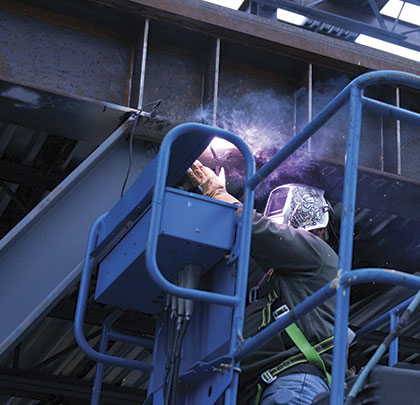Companies are always looking for ways to become more competitive, productive, and profitable. Accurately bidding on jobs, having the right equipment and skilled welding operators, and completing projects on deadline are all imperative to reaching those goals. Safety on the jobsite is also absolutely critical—it is important that companies take steps to minimize hazards that could lead to employee injury.
There are opportunities in the welding operation to implement efficiencies and ensure greater safety, including the use of remote control technology—which in today’s marketplace has evolved to provide significant benefits to that end.
Remote control technology (like Miller® ArcReach™) gives welding operators the ability to set welding parameters at the weld joint, which reduces the need to walk back and forth to the power source to make adjustments—reducing safety risks like trips, slips, and falls—and provides more time to weld. It also eliminates the need to settle for less than optimal welding parameters, resulting in better welds and less rework.
This technology is beneficial for industries where a welding operator is not welding next to the power source. These include large jobsites found in industries such as construction and shipbuilding, where welding can take place hundreds of feet in the air or far away from the power source.
AVAILABLE REMOTE TECHNOLOGY
There are two main types of remote control welding technologies available in the marketplace, but they are not all equal.
- Remote control or RC feeders require weld cables, as well as an additional control cord, which offers full wire feed speed and voltage control at the weld joint.
- The most advanced option available for MIG welding includes a voltage sensing or VS feeder with complete remote control technology—offering wire feed speed, voltage control, and process control via the existing weld cables—no additional cord required. For TIG and stick welding, amperage, arc control, and process control are available via a remote. The control cord is not required. (Note: The remainder of this article will focus on this type of remote control technology.)
Eliminating the control cord—which can contain in excess of 14 wires wrapped in a bundle—reduces cable management by 33 percent, while giving the welding operator complete control at the weld joint and reducing the need to purchase or maintain expensive cords. These reduced costs can add up on jobsites that have dozens or even hundreds of welding machines. In addition, reducing unplanned downtime for the repair and maintenance of older corded options can also eliminate unnecessary costs.
Another benefit: There are no line-of-sight limitations, as the weld cables provide the remote control capability as opposed to radio waves, which can be disrupted by obstructions or distance. As long as the cables are proper sized for the job, they will have the ability to communicate to the power source.
PRODUCTIVITY AND QUALITY GAINS
The ability to control welding parameters at the weld joint offers significant productivity and quality benefits. It reduces the time a welding operator spends walking to the power source to adjust welding parameters. Eliminating that downtime helps improve productivity by allowing more arc-on time. Further, control over the welding parameters makes certain that the welding operator has the most productive weld settings for the weld joint, allowing for the completion of more work in less time.
Likewise, this technology helps prevent weld defects, such as poor penetration or other issues that could require costly and time-consuming rework. Once the welding operator strikes an arc, he or she can see the exact voltage and amperage for the process.
The voltage provides the welding operator with the means to control the weld puddle size and shape, which varies depending on whether welding occurs in a flat, vertical, or overhead position. Without this control, the welding operator may tend to manipulate the welding process via wire stickout (for MIG welding), travel speed or angle of the gun or torch. Similarly, a welding operator may try to burn a stick electrode faster or slower by increasing or decreasing the arc length and travel speed. Ultimately, these adjustments may prevent a welding operator from creating quality welds and it could reduce the speed at which he or she completes it, negatively affecting productivity.
SAFETY BENEFITS
Remote control technologies offer safety benefits for the welding operator in several ways. Reducing unnecessary trips to and from a power source to make adjustments not only reduces exposure to hazards on a jobsite, but it also helps reduce welding operator fatigue that can result from navigating large jobsites. Eliminating the need for the control cord also reduces jobsite clutter, which helps improve welding operator safety by minimizing trips, slips and falls. This is a real benefit, considering OSHA cites falls as being responsible for 349 out of 874 total construction site deaths (39.9 percent) in 2014.
NUMEROUS ADVANTAGES TO CONSIDER
When it comes to operating a safe, efficient, and profitable welding operation, it’s important to look at all aspects that contribute to success. Remote control welding technology that operates without a control cord provides numerous benefits that can help a company increase productivity, improve quality, and reduce operating costs, while also providing the benefits of greater welding operator safety. ■
About the Author:
Brian Hammers is an engineering manager with Miller Electric Mfg. Co. For more information, visit www.millerwelds.com.
_________________________________________________________________________
Modern Contractor Solutions – October 2016
Did you enjoy this article?
Subscribe to the FREE Digital Edition of Modern Contractor Solutions magazine.



